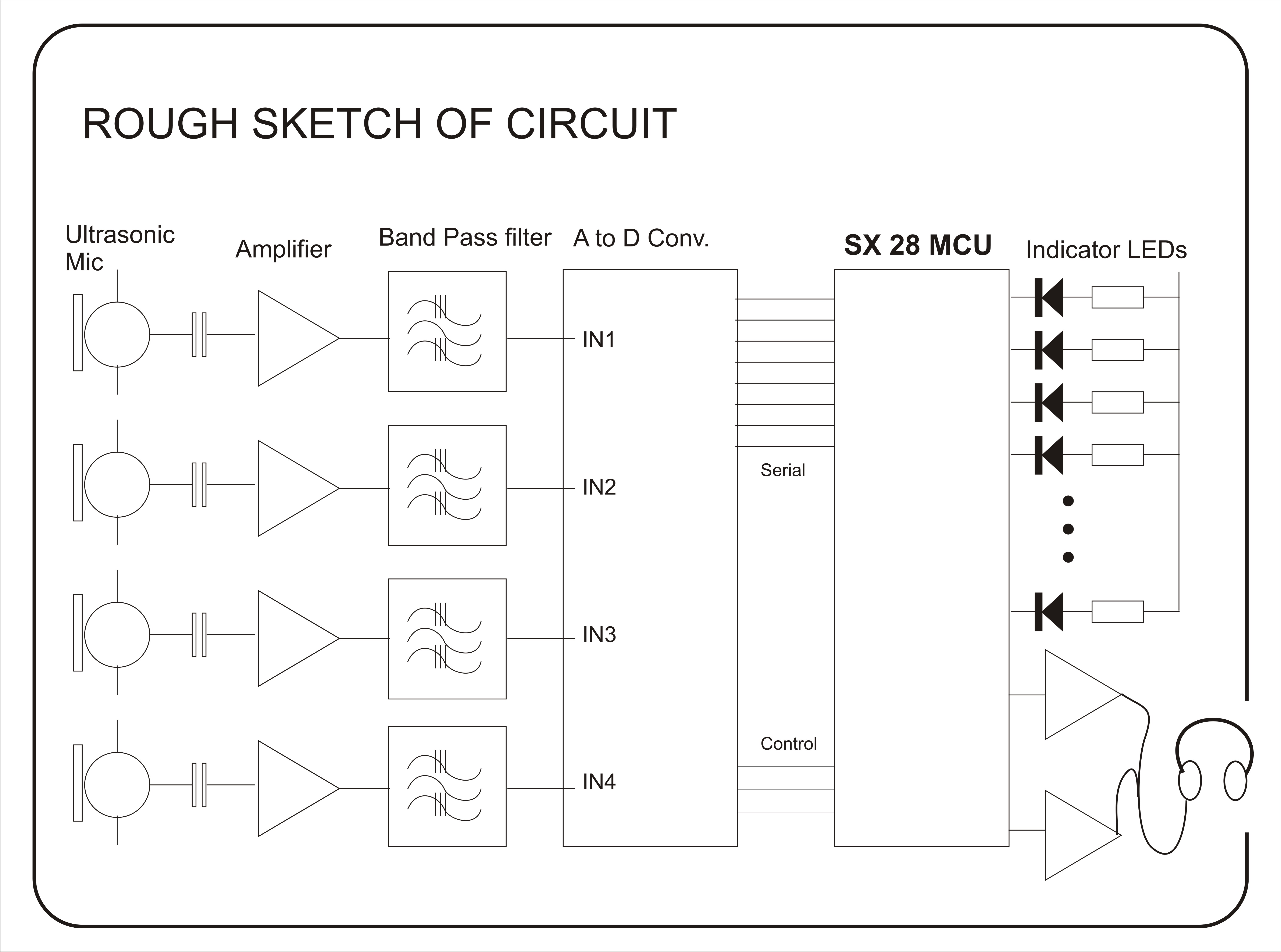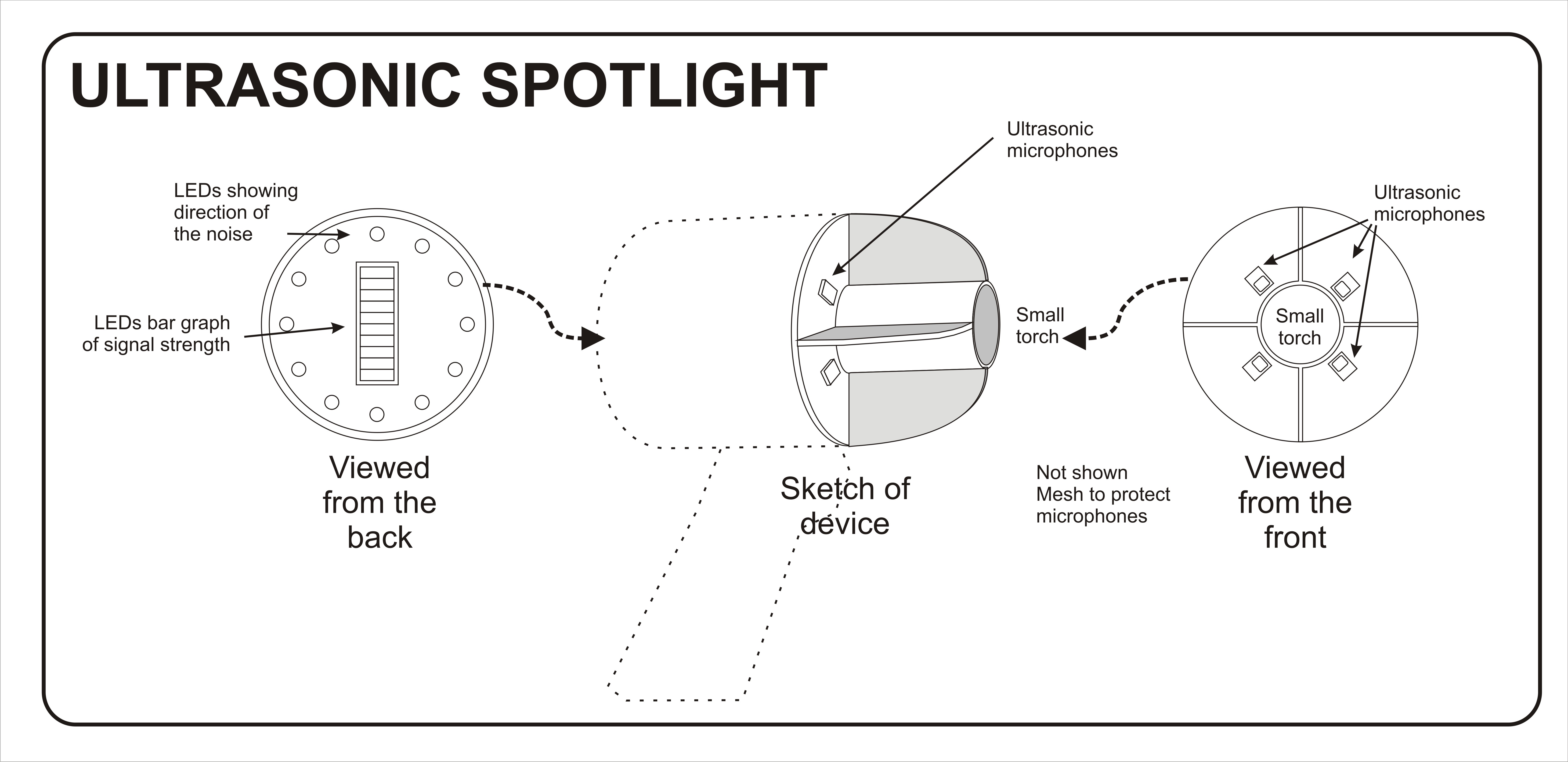Finding bugs - the 6 leg kind
I am fascinated by the old Russian SAM7 anti-aircraft missile. This device had a glass dome on the front that was segmented into four quadrants. In each quadrant was an infrared sensor.·The soldier·aimed it at the aircraft and fired. The sensor with the most signal caused the missile to turn in that direction.
·
A friend wants to find a small critter that emits an ultrasonic chirp. Is there an easy·way to do this? I would appreciate your comments.
·
I thought of using 4 ultrasonic microphones and a torch. ·When the signal from the 4 mics is equal, turn on the torch and Ah! There’s the little chap. She would also like to listen to the chirp on stereo headphones. She thinks the frequency is between 30 and 45KHz so the frequency has to be reduced by a factor of three so she can hear it.
·
My idea at present -
Four identical circuits, each with a mic, an amp and a band pass filter. The signal is then fed to an analogue switch and an 8 bit parallel ADC (or ADC with built-in switch) feeding an SX48. I think the ADC will have to be parallel because the sample frequency will be 50KHz X 7 samples or 350 KHz.
-···········To find the·direction, compare the average signal from opposite mics, display this on a circle of LEDs showing the direction and also a simple signal strength bargraph. When the four signals are roughly the same, turn on the torch.
-········· Handle the signal a bit like an MP3 player does. Sample blocks of the signal at say 7 times the highest frequency. Play these blocks back at 1/3 speed. My thought was to sample the signals in two blocks of 100 bytes, one for each channel of the stereo.
·
I work with Stamps (which are much too slow) and SX48. I think the SX48 should be able to handle this. ·At 50MHz, that’s 140 instructions per sample…
·
What do you think, is there an easier way?
·
John
▔▔▔▔▔▔▔▔▔▔▔▔▔▔▔▔▔▔▔▔▔▔▔▔
·
A friend wants to find a small critter that emits an ultrasonic chirp. Is there an easy·way to do this? I would appreciate your comments.
·
I thought of using 4 ultrasonic microphones and a torch. ·When the signal from the 4 mics is equal, turn on the torch and Ah! There’s the little chap. She would also like to listen to the chirp on stereo headphones. She thinks the frequency is between 30 and 45KHz so the frequency has to be reduced by a factor of three so she can hear it.
·
My idea at present -
Four identical circuits, each with a mic, an amp and a band pass filter. The signal is then fed to an analogue switch and an 8 bit parallel ADC (or ADC with built-in switch) feeding an SX48. I think the ADC will have to be parallel because the sample frequency will be 50KHz X 7 samples or 350 KHz.
-···········To find the·direction, compare the average signal from opposite mics, display this on a circle of LEDs showing the direction and also a simple signal strength bargraph. When the four signals are roughly the same, turn on the torch.
-········· Handle the signal a bit like an MP3 player does. Sample blocks of the signal at say 7 times the highest frequency. Play these blocks back at 1/3 speed. My thought was to sample the signals in two blocks of 100 bytes, one for each channel of the stereo.
·
I work with Stamps (which are much too slow) and SX48. I think the SX48 should be able to handle this. ·At 50MHz, that’s 140 instructions per sample…
·
What do you think, is there an easier way?
·
John
▔▔▔▔▔▔▔▔▔▔▔▔▔▔▔▔▔▔▔▔▔▔▔▔




Comments
These kinds of projects are always the most fun ! Your post caught my attention because I'm researching ultrasonics a little now.
My initial thought was to suggest a Propeller as there's already audio code for it that's interesting and possibly applicable. The SX
seems fast enough, if I understand correctly what you're attempting. Some other thoughts:
@30 to 45KHz, 1/3 speed will produce 10 to 15kHz. Unless the headphones are good, the upper end might be attenuated. Also, consider your friends age - if she's young, she'll hear. I just ran 14-18kHz from my sig.gen. through a good amp and speakers, watching with a o'scope --- I couldn't hear it anymore past 16kHz :-( (Too much loud guitar playing in my youth [noparse]:)[/noparse] ... anyway... maybe drop to 1/4 or even 1/5 speed.
I've not tried stuff like this in a while, but I wonder if just dropping samples will cause some weird decimation distortion. If you need to do a more proper transposition, then bandwidth might become an issue ... again... I'm not certain - sure other's will jump in here and correct me.
RE LED's and Torch - consider using dimmer red LEDs and put a red filter on the torch. Every time a white light comes on, it will ruin her night vision. (Ask any astronomer what they think of getting a torch in the eyes during observations [noparse]:)[/noparse] (And, BTW, what do you all call a 'torch' with flames? And does "flashlight" sound as funny to you as 'torch' does to me ;-P )
RE Ultrasound pickups - although these frequencies are highly directional already, consider putting in a small. cross-shaped "+" baffle to better segment and differentiate the source. Hey, it's like a shot-gun microphone --- so you could actually make several baffles with various depths that would concentrate the cone of focus.
RE Input - there might also be some simple op-amp comparators that could simplify the front-end, maybe even making the ADC unnecessary. A quick google search on:
ultrasonic op-amp comparators
turned up some interesting things.
[noparse][[/noparse]EDIT - just dawned on me that Parallax's Ping))) works around 40kHz ! range of ~3 m - might be longer if you're only picking up -- so, if you have any of them lying around... ]
Keep us posted!
Cheers
- Howard
▔▔▔▔▔▔▔▔▔▔▔▔▔▔▔▔▔▔▔▔▔▔▔▔
Post Edited (CounterRotatingProps) : 7/1/2009 3:18:03 PM GMT
Don't forget that you will need a band pass filter on each mic to pick up only the frequencies of interest and reduce background noise.
was thinking too that since she doesn't know exactly what freq. the critters chirp at, you might want to either catch a real sample (audio, that is) or make the filter sweepable.
- And if you want to get really fancy, replace the Visable light torch with an IR and give her some night vision goggles [noparse][[/noparse]8]-)
▔▔▔▔▔▔▔▔▔▔▔▔▔▔▔▔▔▔▔▔▔▔▔▔
http://forums.parallax.com/forums/default.aspx?f=25&m=363462
▔▔▔▔▔▔▔▔▔▔▔▔▔▔▔▔▔▔▔▔▔▔▔▔
▔▔▔▔▔▔▔▔▔▔▔▔▔▔▔▔▔▔▔▔▔▔▔▔
propmod_us and propmod_1x1 are in stock. Only $30. PCB available for $5
Want to make projects and have Gadget Gangster sell them for you? propmod-us_ps_sd and propmod-1x1 are now available for use in your Gadget Gangster Projects.
Need to upload large images or movies for use in the forum. you can do so at uploader.propmodule.com for free.
ConterRotatingProps
- Your comment on the torch and LEDs being too bright is a good one, I'd not thought of that.
- I tested my hearing, I can't hear above 13.2Khz - Thanks (so much for my 20K HiFi speakers!)
- The mics I'm thinking of using are omni-directional so all my direction control will have to come from baffles
Talking of torches and differences in our language, a Robot is that pole with red, green and yellow lights at road intersections that control traffic flow, You guys call them traffic lights. A boot is that storage at the back of a car (automobile) that you call a trunk. What you call a hood, we call a bonnet. Hey, we don't even spell colour (color) the same way. Ever wondered why no one understands you Americans, and we say that we speak the same language.
Kwinn
I’d discarded the two opamp idea early (that’s how the SAM7 did it, small valve opamps) but it would be much, much easier, thanks. I need to think this through some more. K.I.S.S.
RickB
The idea of heterodyne is worth following up, thanks (much simpler!)
This is more input than I expected.
Kind regards from South Africa on the Dark Continent (we don’t have flashlights, only torches. That's why its dark)
John Bond
▔▔▔▔▔▔▔▔▔▔▔▔▔▔▔▔▔▔▔▔▔▔▔▔
Actualy, under sampling (less than 2 samples/cycle is used to produce a low frequency alias of the input frequency. This is how sampling scopes work. No fft needed. How ever, the input stream needs to be long enough to get enough samples to build an accurate picture of the input waveform. Doesn't work on oneshot pulses. The bug chirps may or may not be long enough.
Post Edited (RickB) : 7/2/2009 3:02:43 PM GMT
Yes, that was my not-thinking post, not John's mistake. Right, you have to interpolate samples. As you say Rick, this gets messy if the sample length is too short. Is the superhet phenomenon basically smart use of sum and difference frequencies - so, in this case, you'd use the difference freq.?
▔▔▔▔▔▔▔▔▔▔▔▔▔▔▔▔▔▔▔▔▔▔▔▔
Correct. Just adjust the local osc. to bring the diff freq to a listenable freq and lowpass filter it to get rid of the fundamental and sum.
Here are some examples that work as bug detectors also.
http://njsas.org/projects/bat_detector/img/populel_orig.gif
http://bertrik.sikken.nl/bat/index.html
Found another one
http://www3.telus.net/chemelec/Projects/Ultrasonic/Ultrasonic-1.htm
There is a whole world of ultrasonic chirps, whistles, and buzzes out there that can be heard with one of these.
Post Edited (RickB) : 7/3/2009 8:56:01 PM GMT
This stuff is incredably useful. I was planning on the frequency devision solution but just using a 567 seems to be an easier solution, I have a couple in stock that·I didn't know what I was going to do with.
Time to start playing!!!
Kind regards on this fine clear·winters day (yes, we are a bit mixed up with our seasons).
John Bond
▔▔▔▔▔▔▔▔▔▔▔▔▔▔▔▔▔▔▔▔▔▔▔▔
The frequency division is a quick and simple circuit so I am building it first to gain some knowledge.
I bought some mics and 40K transducers on Saturday (travelled 100 miles to get them). I'll have to work out how one uses electret mics. My lack of audio experience shows.
I built myself a signal generator yesterday using an SX (and resistor ladder). I'll program it this week. I have a piezo speaker that has a fairly flat resopnse up to 50kHz (3dB). That'll make a good ultrasound source.
Let the fun begin...
Thanks again
John
▔▔▔▔▔▔▔▔▔▔▔▔▔▔▔▔▔▔▔▔▔▔▔▔